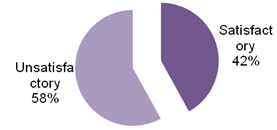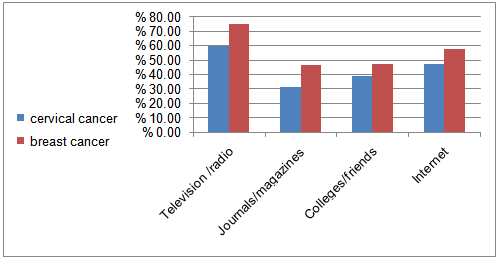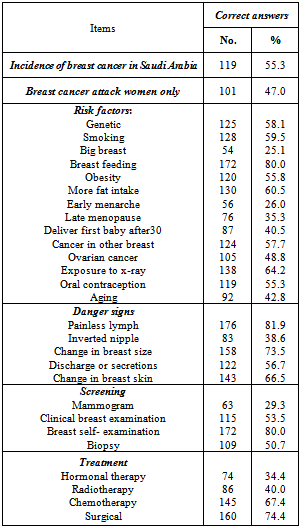-
Paper Information
- Next Paper
- Paper Submission
-
Journal Information
- About This Journal
- Editorial Board
- Current Issue
- Archive
- Author Guidelines
- Contact Us
International Journal of Nursing Science
p-ISSN: 2167-7441 e-ISSN: 2167-745X
2012; 2(5): 47-52
doi: 10.5923/j.nursing.20120205.01
Saudi Young Females' Level of Knowledge Regarding Cervical and Breast Cancer
Magda Mohamed Mohamed Bayoumi, Mona Mohamed Megahed Elbasuny, Afnan Mohsen Ahmed Nasser, Kholood Mohamed Abdullah, Noura Mohamed Ali Al matery
Nursing Department, College of Applied Medical Sciences Mohail Asser, King Khalid University
Correspondence to: Magda Mohamed Mohamed Bayoumi, Nursing Department, College of Applied Medical Sciences Mohail Asser, King Khalid University.
| Email: |  |
Copyright © 2012 Scientific & Academic Publishing. All Rights Reserved.
Breast cancer is currently the top cancer in women in the entire world, the most common cancer site in the 13 administrative regions of Saudi Arabia was breast cancer the leading cancer among women. Cervical cancer ranks as the 2nd most frequent cancer in women between 15-44years of age. Incidence of cervical cancer in Saudi Arabia was 4.6 per 100.000 women. Our aim to evaluate level of knowledge regarding cervical and breast cancer among young females. A cross –sectional study was conducted from young females at science& Art College and health science college. Interviewing structured questionnaire was used to collect data.; the questionnaire divided into three parts covered socio demographic data, breast cancer knowledge and cervical cancer knowledge among 215 students' with different age, parity and marital status were selected randomly. Out of 215 female student mean age was 22.6(9.4), 58% of study sample had unsatisfactory level of knowledge regarding cervical and breast cancer, only 21.9% Know HPV vaccine, Television and radio were the most frequent 74.9%, 59.5% source of knowledge about breast and cervical cancer among study sample. In conclusion more efforts must be focused in provide proper education and reassurance our young females about danger health issues .
Keywords: Level o Knowledge, Breast Cancer, Cervical Cancer
Cite this paper: Magda Mohamed Mohamed Bayoumi, Mona Mohamed Megahed Elbasuny, Afnan Mohsen Ahmed Nasser, Kholood Mohamed Abdullah, Noura Mohamed Ali Al matery, "Saudi Young Females' Level of Knowledge Regarding Cervical and Breast Cancer", International Journal of Nursing Science, Vol. 2 No. 5, 2012, pp. 47-52. doi: 10.5923/j.nursing.20120205.01.
Article Outline
1. Introduction
- Cancer is the leading cause of death worldwide and account for 7.6 million deaths around 13% of all deaths. Deaths from cancer are projected to continue to rise to cover 12 million in 2030.1 breast cancer is currently the top cancer in women in the entire world and the leading cancer killer among women aged 20-59 years in high–income countries compared to low and middle-income countries, but mortality is similar. It has been reported that each year, over 1.15 million women worldwide are diagnosed with breast cancer and 502,000 die from disease.2,3Saudi Arabia has total population 25,721,000 million, of which about 6million are expatriate. The population is overwhelmingly young, with 45.7% females. The total number of cancer cases analyzed among Saudis during the year 2004 was 6,969. Of those cases 50.1 %( 3,491) were reported among women. The most common cancer site in the 13 administrative regions of Saudi Arabia was breast cancer the leading cancer among women. 1, 4Breast cancer largely viewed as a disease predominantly influenced by risk factors related to lifestyle, familial and genetic influences, hazardous effects of hormonal exposure, early age at menarche, late age at menopause, small number of children and nulliparity, late age at first birth, and no breast feeding have all been associated with an increased risk of developing breast cancer.5 early detection of breast cancer can lead to greater likehood of cure, the recommended early detection strategies are awareness of early signs and symptoms through screening by breast self-examination, clinical breast examination, and mammography screening.6Cervical cancer is the second common type of cancers among women in the world and also ranks as the 2nd most frequent cancer in women between 15-44years of age as well as women of all ages in Asia. Incidence of cervical cancer in Saudi Arabia was 4.6 per 100.000 women. 7Cervical cancer is cancer of the uterine cervix. The ACS (American Cancer Society) estimated that over 12.000 cases of invasive cervical cancer diagnosed; approximately 3.000 of these women will die. Human papillomavirus (HPV) is a sexually transmitted infection, recognized as the necessary cause of 99% of all cervical cancers, other risk factors include: family history of cervical cancer, early sexual debut age, lack of regular Pap smear testing, as well as number of pregnancies.8 Awareness is the first step toward change and is a paramount importance. The aim of current study is to evaluate level of knowledge regarding cervical and breast cancer among young females.
2. Methodology
2.1. Study Design and Population
- This cross –sectional study was conducted from October 2011 to December 2011 among young females at science& Art College and health science college, Mohaiel Asser, king Khalid University, Saudi Arabia. Study sample selected randomly. Total selected sample was 215 students' with different age, parity and marital status.
2.2. Data Collection
- Interviewing structured questionnaire was used to collect data. It designed by researcher based on the related literature, it tested for validity on twenty students who excluded from study sample. The study tool divided into three parts and covered the following items; part (1) socio demographic data (age, college, level, marital status, parity, history of cancer, and source of knowledge …). Part (2) breast cancer knowledge (incidence in Saudi Arabia, risk factors, danger signs, screening, treatment).part (3) cervical cancer knowledge (hear about cervical cancer, risk factors, danger signs, HPV vaccine, pap smear, and treatment).Written consent was obtained from college dean and students verbal consent gotten individually to conduct study. Scoring system: The total knowledge score for total knowledge questions and sub questions (42), divided as: 0>26 indicated unsatisfactory knowledge and 26-42 indicated satisfactory knowledge.
2.3. Data Analysis
- The collected data was analyzed using statistical package for social science (SPSS) version 15. Data were presented using descriptive statistics in the form of frequencies and percentages for qualitative variables.
3. Results
- The total study sample was 215 female students, 66% were Science& Art College students. Demographic characteristics of the study sample are presented in Table 1. The study sample mean age was 22.6(SD+9.4), with the majority of them 177(82.3%) single; 192(89.3%) nulliparous. 5.6% have family history of breast cancer. 45.1% of study sample not hear before about cervical cancer. As regard breast cancer knowledge Table 2. Clarified that simply 10.7% of study sample reported incidence of breast cancer in Saudi Arabia (10%), 101(47.0%) of them not considered breast cancer attack women only. In relation to breast cancer risk factors correct answers; the majority 80% consider breast feeding not risk factor and 60.5% consider fatter intake, 59.5% smoking, 58.1% genetic, and 55.8% obesity were risk factors but only 35.3%, 26.0% respectively appreciate menopause and early menarche as major risk factors. Painless lump (81.9%) and change in breast size (73.5%) were the most frequent correct danger signs among study sample. 80.0% aware of breast self–exam as breast cancer screening method but only 29.3% aware of mammogram as the most screening method. more than two third(74.4) recommended surgery as a treatment for breast cancer.
|
 | Figure 1. Psrticipants′ level of knowledge regarding cervical and bteast cancer (n=215) |
|
|
 | Figure 2. Participants ' source of information regarding cervical and breast cancer(n=215) |
4. Discussion
- Cancer incidence increases at faster rate with increasing age in young women, their cancers tend to be larger and higher grade with poorer prognostic characteristics, resulting in a higher risk of recurrence and death.9 Our study sample had a lack of knowledge about cervical and breast cancer, the most common cancers affected women in this young age, more than half of them had unsatisfactory level of knowledge. Previous studies confirmed our result. 10, 11
4.1. Breast Cancer Knowledge
- The current study revealed that simply 10.7% of sample reported correct incidence of breast cancer in Saudi Arabia. Regard assessed risk factors in the present study the most frequent identified risk factor were family history, smoking and fatter intake, our result similar to study conducted in Malaysia among female university students.12 Less than one third considered big breast as a risk factor of breast cancer, in contrast of Iranian study carried out among women attending medical centers, 13 young females in our study not appreciate menopause and early menarche as major risk factors, the same result reported by previous studies in different population.12, 14 Aware of breast cancer danger signs improve breast cancer self-early detection and treatment, the majority of our sample reported painless lump and change in breast size as a most frequent signs while inverted nipple represented only one third, same result explained by other investigators.15,16 In the study conducted in Saudi Arabia among university female students aged from18 to 39 year, only few women knew that nipple retraction 27.9% and nipple discharge 42.9% are warning signs of breast cancer.17 another study conducted among African American women the majority women aware that abnormal discharge from the nipple is a possible sign of breast cancer.18 Breast self-examination (BSE) is one of the important steps for identifying breast tumors at an early stage and has positive effect on the early detection, the American cancer society recommended breast self- examination to be performed monthly beginning at the age of twenty,19 more than two third indicate BSE most frequent breast cancer screening method, the same result showed by different studies. 20, 21, 22 Mammogram is considered to be the forerunner in early detection of breast cancer but in the present study less than on third aware of mammogram as screening method. All breast cancer treatment alternatives identified by study sample. Undergoing surgery especially mastectomy involves loss of body part, however about two third of study sample choice surgery.
4.2. Cervical Cancer Knowledge
- Cervical cancer is a major health problem, slightly half of our study sample heard about cervical cancer. Concerning cervical cancer risk factors, only 49.8% aware of HPV infection, however HPV recognized as the necessary cause of 99% of all cervical cancers. The same result reported in other studies among different population. 23,24,25,26 Other risk factors frequently stated include sexual disease, oral contraceptives, and sex early. Similar to study conducted in Pakistan among interns.27 the most frequently cervical cancer symptoms was post coital bleeding, in the present study it reported by 59.1%, this finding similar to other study.28 during the last years, two vaccines were markets to prevent cervical infection with human papilloma virus (HPV) worldwide.29 Less than one third of our study sample know about HPV vaccine in contrast with study carried in Belgium among adult women (mean age 37).30 while another studies presentations show poor information about HPV vaccine.31,32,33 Cervical cancer is largely preventable by effective screening programs and considerable reduction in cervical cancer incidence and deaths by systematic cytological smear screening programs.34 nearly two third in our present study aware of pap test as early detection screening method of cervical cancer. Similar result reported by previous studies.35, 36, 37
4.3. Source of Information
- Mass media was easily accessible and provide wide range of information, this explain our findings that mass media represented the most common source of information for cervical and breast cancers among present participants, similar findings were reported in previous studies.38, 39, 40 Followed by colleges and friends in contrary with other researchers who found that the main source of information was friends and colleagues.41
5. Conclusions
- Overall, there is limited knowledge regarding cervical and breast cancer among university female students. Furthermore they not aware of screening programs for cancer early detection or HPV vaccine to prevent cervical cancer. More efforts must be focused in provide proper education and reassurance our young females about danger health issues. Posters and pamphlets in the university campus should be developed to increase heath awareness, and implemented educational programs as a part of extracurricular activities.
ACKNOWLEDGEMENTS
- This scientific research was funded by centre of talent and creativity, king Khalid university.
 Abstract
Abstract Reference
Reference Full-Text PDF
Full-Text PDF Full-Text HTML
Full-Text HTML

